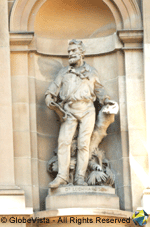Ludwig Leichhardt statue

Public Art: Ludwig Leichhardt statue
Sculptor: ©
Description: The sandstone carving of Dr Ludwig Leichardt, Prussian explorer and naturalist, is one of 23 sandstone carved figures on the ledges of the Lands Department Building.
Date Unveiled: c1891
Location: The statue of Dr Leichardt can be found in a niche on the Bridge Street facade of the Department of Lands Building, Bridge Street, Sydney, Australia.
So who was Dr Ludwig Leichhardt? : Friedrich Wilhelm Ludwig Leichhardt (23rd October 1813 – c.1848) was a Prussian explorer and naturalist who famously explored northern and central Australia before vanishing.
Leichhardt was born in Trebatsch. He studied philosophy, language, and natural sciences at the Universities of Gottingen and Berlin but never completed any university degrees.
In 1842 Leichhardt ventured to Australia in the hope of joining an expedition into inland Australia. After dabbling in a few specimen-collecting journeys on his own he applied to be part of a proposed government-sponsored expedition to Port Essington in the Northern Territory. When the expedition was canceled, the disappointed Leichhardt decided to seek funding privately to continue the expedition himself.
Leichhardt and his team set sail for Moreton bay in August 1844 and were met by four more volunteers at Moreton Bay. On the 1st of October, 1844, the team departed overland from Jimbour on the Queensland Darling Downs. Not a word was heard from them for over a year and everyone expected they had perished when suddenly Leichhardt and his team appeared at Port Essington on 17 December 1845. They had traipsed an astonishing 4,800 km (3,000 mi).
Leichhardt returned to Sydney a hero and it wasn’t surprising that his next expedition, from Darling Downs to Western Australia, would be funded by the government and substantial private subscriptions. The team set off in 1847 but due to heavy rain, malarial fever, and famine they were forced to abandon the expedition and return to Sydney, having only covered 800kms.
When Leichhardt had fully recovered from his malaria he set about to again attempt the expedition to Western Australia. The last ever sighting of Leichhardt and his team was on 3 April 1848 at McPherson’s Station, Coogoon, on the Darling Downs. Somewhere in Australia’s vast interior the men vanished. What happened and where they perished still remains a mystery as the expedition was expected to last between two to three years. It was only after that time, did anyone realise they were missing.
Clues To Leichhardt’s Fate
The first Government search for Leichhardt was under Hovenden Hely and was conducted four years after he disappeared. It found nothing except a campsite with an “L” and “XVA” marked on a tree.
In 1858 another search by Augustus Gregory found a few more trees marked with “L”. In 1864 Duncan McIntyre discovered two trees marked with “L” on the Flinders River near the Gulf of Carpentaria.
In 1864 rumours began spreading in Western Australia about a place where the remains of horses and men, who had been killed by local aborigines, had been seen. A subsequent search found nothing.
During an expedition through the Gibson and Great Sandy Deserts in 1896, David Carnegie met some Aborigines who had an iron peg, the lid of a tin matchbox and part of a saddle. Carnegie believed these items could have belonged to Leichhardt’s expedition.
In 1900 an Aboriginal stockman near Sturt Creek (just near the Western Australia/Northern Territory border) discovered a tiny brass plate marked “LUDWIG LEICHHARDT 1848” attached to a partially burnt shotgun slung in a boab tree. The tree also was engraved with the letter “L”. In 2006 Australian historians and scientists authenticated the plate as belonging to Leichhardt. It seems he completed two-thirds of his journey.